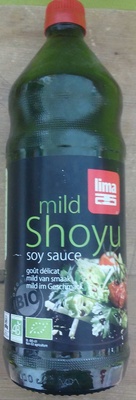Viewed 2 times...
Sauce de soja
Short Description
Lima Shoyu Soya Sauce Do not simply use them to salt, but also to intensify the natural taste of ingredients during cooking and at the table. The taste of Shoyu is characterised by a slight touch of alcohol resulting from the fermentation of wheat. That is why it is not very suitable for prolonged heating and should be added at the end of the preparation process, so that it does not lose its flavour. Shoyu is perfect for pickles, in the wok, with rice, with noodles, with sushi, sashimi or steamed vegetables. It is delicious in combination with mirin (rice wine) , wasabik ginger or grated daikon. The Lima Shoyu (soya and wheat) and Tamari Classic (pure soya) are made by the Sato family, an old Japanese family that has been passing on traditional knowledge and recipes for eight generations. The establishment of their company in Kuwana, to the soutwest of Tokyo, dates back to 1804. Since 1985 these sauces have been produced in the United States, where the Sato family has established a branch in order to better meet the demands on this continent. The art of fermentation -The nutritional value of soya is indisputable. Only disadvantage of raw soya : it is not easily assimilated by the organism. The main merit of fermented soya lies in the transformation of the soya into easily digestible nutrients. (The same process as that which takes place during the production of Miso and Tempeh, which are also made on the basis of fermented soya) The fermentation contributes to the natural preservation of the sauces and gives them their characteristic fermented taste. Fermentation is perfect when the moromi (mixture of soya (in case of Shoyu combined with wheat), enzymes, water and sea salt) has fermented totally and homogeneously. The activity of the fermentation depens on the weather conditions : 12 to 24 months according to the season, approximately 6 months in chambers under controlled temperature. An exaggerated fermentation period causes oxidation to start, which has a negative effect on the final quality of the sauce. The signs of a sauce that is too old are a continued fermentation, also called wild fermentation, and a whitish deposit in the bottle. The product begins to taste and smell like ammonia and no longer resembles a high-quality soya sauce. The nutritional advantages of fermentation During the long fermentation process, natural enzymes transform the starch, the proteins and the fast of raw soya (and of wheat in case of Shoyu) into nutrients that are easily assimilated by the organism, as they are predigested : amino acids, poly-unsaturated. Lima Shoyu 1000ml. Sauce made with naturally fermented soya and wheat. Shoyu and Tamari are taste enhancers, healthy and liquid versions of stock cubes. They are suitable for western as well as oriental dishes. Other optionsLong Description
| Details: | |
| Wikipedia: | Visit |
| Manufacturer: | Lima |
| Origin: | |
| Barcodes: |

| Nutrition Facts | |||
|---|---|---|---|
| Serving Size: | |||
| Ammount per Serving: | |||
| Calories: | kcal | ||
| Details in % | Daily Value | ||
| Total Fat | % | g | |
| Satured Fat | % | g | |
| Trans Fat | % | g | |
| Polyunsatured Fat | % | g | |
| Monounsatured Fat | % | g | |
| Cholesterol | % | mg | |
| Sodium | % | mg | |
| Potassium | % | mg | |
| Total Carbohydrate | % | g | |
| Dietary Fiber | % | g | |
| Sugars | % | g | |
| Other carbohydrate | % | g | |
| Protein | % | g |

